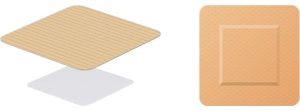Challenges in Developing Adhesive Layers for Medicinal Patches
José María Altinier – Supervisor of Galenic Development
Ensuring adhesion throughout its usage period is a critical requirement in the development of medicinal patches to provide patients with safe and reliable products. One of the tools we have to meet this requirement is the use of adhesive overlays that cover the patch and ensure its adhesion throughout its usage period.
In the design of a medicinal patch, various requirements must be considered, such as the release of the active ingredient at the indicated dose and the stability of the product throughout its shelf life, among others. One of these requirements is effective adhesion during the declared usage period of the medication, which translates to how much of the patch’s surface remains in intimate contact with the skin at the end of its usage period. This requirement is of utmost importance because, for the active ingredient to pass from the patch to the skin (absorption), effective contact between both surfaces must be ensured.
But what happens when a formulation has low adhesiveness or simply fails to achieve effective adhesion during usage periods that can last up to 7 days?
In such cases, it is necessary to incorporate an adhesive overlay that covers the patch and ensures its adherence. The adhesive overlay is, in short, an additional patch larger than the active patch, placed over it, covering it entirely. It can be presented separately from the patch for the patient to assemble at the time of application or incorporated into the patch during manufacturing, making it a multi-layer device.
The overlay does not contain the active ingredient and must have greater adhesiveness than the patch it covers to ensure effective adherence throughout the entire usage period. Therefore, formulating an overlay presents a series of challenges that must be resolved for it to perform its function.
The first characteristic to consider is the composition of the adhesive overlay, which may be similar to or different from the active patch, depending primarily on the adhesive capability we seek. An essential point in this selection is that the overlay’s composition must be compatible with the active ingredient and the other excipients in the patch since they are in intimate contact along the entire patch perimeter. An incorrect choice could lead to the formation of undesirable impurities in the product.
Another crucial characteristic is the size of the overlay relative to the active patch. On the one hand, an overlay provides a larger contact surface than the patch, enhancing the overall adhesiveness. However, this larger size could complicate the patient’s application or use. The defined size of the adhesive overlay will balance these two factors.
Finally, a particular characteristic of adhesive overlays to consider is their ability not to solubilize or transport the active ingredient contained in the patch. As mentioned at the beginning, the absorption of the active ingredient from the patch to the skin is related to the effective contact surface between both. If the active ingredient could be transported from the patch edge to the overlay via diffusion, it could diffuse into the skin across the overlay’s entire surface, altering the originally defined release for the patch. This characteristic becomes critical in high-potency medications as it could lead to overdose and consequent harm to the patient. For this reason, it is not advisable to interchange overlays between different medicinal patches or use household adhesive tapes to cover the patches.
Conclusion:
Considering the aforementioned points, we can affirm that developing an adhesive overlay to ensure the adhesion of a medicinal patch throughout its usage period presents challenges that must be understood and resolved by the professionals responsible for its formulation. This ensures that patients receive safe, reliable products with proven efficacy throughout their shelf life.
Subscribe to
#AmarinNews
Partner with us!
We offer expertise and experience, together with flexibility and the ability to adapt to your needs.
- info@amarintech.com.ar
- +54 11 4588-6500
- Sanchez 2045 (C1416BQG), Buenos Aires, Argentina.


